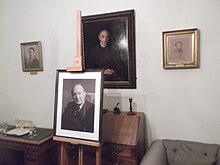Edmund John Bowen
Edmund "Ted" John Bowen , mostly quoted by EJ Bowen, (born April 29, 1898 in Worcester , † November 19, 1980 in Oxford ) was an English chemist in the field of physical and photochemistry .
biography
Bowen attended the Worcester Royal Grammar School and studied as a Brackenbury Scholar from 1915 chemistry at Oxford University , interrupted from service in the artillery in the First World War as a second lieutenant. After the war he continued his studies and in 1922 became a Fellow of University College Oxford. He was Domestic Bursar of University College and in 1936 Junior Proctor of Oxford University. In 1965 he retired and became an Honorary Fellow of the University College.
He did research on photochemistry - including fluorescence - at the Balliol Trinity laboratories. In 1942 he published an important textbook on photochemistry.
In 1963 he received the Davy Medal . He was a Fellow of the Royal Society (1935), Vice President of the Chemical Society and President of the Faraday Society.
He was married to Edith Moule and had a son and a daughter. His son Humphry Bowen (1929–2001) was a chemist and botanist, known for Bowen's Kale - reference material made from trace elements for calibrating scientific instruments.
Bowen was interested in geology and paleontology and gathered around the Ringstead Bay area on the Jurassic Coast of Dorset . The Jurassic ammonite Perisphinctes boweni Arkell 1935 is named after him.
Fonts
- The Chemical Aspects of Light, Oxford: Clarendon Press 1942, 2nd edition 1946
literature
- RP Bell : Oxford Dictionary of National Biography , 2004
Web links
| personal data | |
|---|---|
| SURNAME | Bowen, Edmund John |
| ALTERNATIVE NAMES | Bowen, Ted |
| BRIEF DESCRIPTION | English chemist |
| DATE OF BIRTH | April 29, 1898 |
| PLACE OF BIRTH | Worcester |
| DATE OF DEATH | November 19, 1980 |
| Place of death | Oxford |
